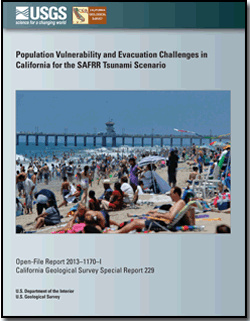 Abstract Abstract
The SAFRR tsunami scenario models the impacts of a hypothetical yet plausible tsunami associated with a magnitude 9.1 megathrust earthquake east of the Alaska Peninsula. This report summarizes community variations in population vulnerability and potential evacuation challenges to the tsunami. The most significant public-health concern for California coastal communities during a distant-source tsunami is the ability to evacuate people out of potential inundation zones. Fatalities from the SAFRR tsunami scenario could be low if emergency managers can implement an effective evacuation in the time between tsunami generation and arrival, as well as keep people from entering tsunami-prone areas until all-clear messages can be delivered. This will be challenging given the estimated 91,956 residents, 81,277 employees, as well as numerous public venues, dependent-population facilities, community-support businesses, and high-volume beaches that are in the 79 incorporated communities and 17 counties that have land in the scenario tsunami-inundation zone.
Although all coastal communities face some level of threat from this scenario, the highest concentrations of people in the scenario tsunami-inundation zone are in Long Beach, San Diego, Newport Beach, Huntington Beach, and San Francisco. Communities also vary in the prevalent categories of populations that are in scenario tsunami-inundation zones, such as residents in Long Beach, employees in San Francisco, tourists at public venues in Santa Cruz, and beach or park visitors in unincorporated Los Angeles County. Certain communities have higher percentages of groups that may need targeted outreach and preparedness training, such as renters, the very young and very old, and individuals with limited English-language skills or no English-language skills at all. Sustained education and targeted evacuation messaging is also important at several high-occupancy public venues in the scenario tsunami-inundation zone (for example, city and county beaches, State or national parks, and amusement parks). Evacuations will be challenging, particularly for certain dependent-care populations, such as patients at hospitals and children at schools and daycare centers. We estimate that approximately 8,678 of the 91,956 residents in the scenario inundation zone are likely to need publicly provided shelters in the short term. Information presented in this report could be used to support emergency managers in their efforts to identify where additional preparedness and outreach activities may be needed to manage risks associated with California tsunamis.
|
First posted September 3, 2013
This report is presented in Portable Document Format (PDF); the latest version of Adobe Reader or similar software is required to view it. Download the latest version of Adobe Reader, free of charge. |